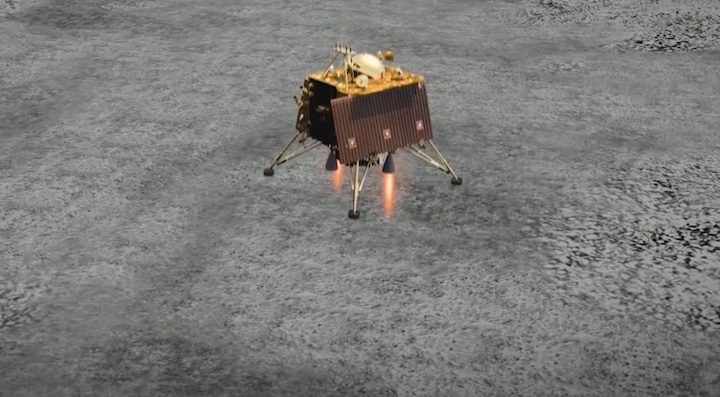19.09.2019

PHOENIX — The apparent failure of an Indian spacecraft to land on the moon this month is providing a reminder to NASA and its commercial partners of the challenges of not only the missions themselves but sharing data on problems they experience.
The Indian Space Research Organisation (ISRO) lost contact with the Vikram lander, part of its Chandrayaan-2 mission, during the final stages of is descent to the lunar surface Sept. 6, with the last signals received when the spacecraft was at an altitude of 2.1 kilometers. ISRO has not heard from the lander since.
ISRO has released few details about effort to locate and restore contact with the lander. A Sept. 10 statement, the most recent one from ISRO, said that the Chandrayaan-2 orbiter had taken an image of the lander, but said nothing about the state of the lander beyond the continued lack of communications. ISRO also hasn’t released the image.
An ISRO spokesperson said in a Sept. 17 email that it would provide updates on its website and through social media, but didn’t state when ISRO planned to publish such updates. NASA’s Lunar Reconnaissance Orbiter is scheduled to observe the landing site Sept. 17, although it wasn’t clear how long it would take for mission scientists to receive, analyze and publish any images.
Time is running out to reestablish contact with Vikram. The landing site it nearing the end of its two-week daytime period, and the lander was not designed to survive the equally long night.
If Vikram crashed during landing, as many fear, it will be the second spacecraft this year to fail to land on the moon intact. Beresheet, a lander built by Israel Aerospace Industries for SpaceIL, suffered a malfunction during a landing attempt in April, causing the spacecraft to crash to the surface. Unlike Vikram, the mission team declared the landing unsuccessful shortly after losing contact.
Those failures are taking place as NASA is working with nine companies in the Commercial Lunar Payload Services (CLPS) program on robotic lunar landers that can carry NASA research payloads to the surface of the moon. Two of those companies, Astrobotic and Intuitive Machines, have awards from NASA to carry payloads on missions scheduled for launch in 2021.
None of the nine companies have yet to fly their landers, and the recent failures provide a reminder of how difficult it is to soft-land on the moon.
“From a management perspective, we just know this is hard and it’s clear that our contractor pool has a steep challenge on their hands,” said Camille Alleyne, deputy manager of the CLPS program at NASA’s Johnson Space Center, during a Sept. 12 panel discussion at the American Astronautical Society’s Wernher von Braun Memorial Symposium in Huntsville, Alabama.
That panel included representatives of two of the companies on the CLPS program. “I think both the SpaceIL and ISRO missions were huge successes” despite their landing failures, said Sharad Bhaskaran, mission director at Astrobotic. “I think our challenge is to learn from those missions, understand what happened, make sure we don’t make the same mistakes.”
“Just imagine how far we’ve come,” said Seamus Tuohy, principal director of space systems at Draper. Even a few years ago, he said, it was difficult to convince people that a lunar lander could be built “without necessarily an entire federal program behind it.”
“It does remind us that it is difficult to complete 100% the entire mission,” he continued, “but I think it motivates us to make sure that, when we go, that we’re successful.”
While Bhaskaran called for sharing information about the causes of the Beresheet and Vikram lander failures, there is no formal mechanism within the CLPS program for companies to exchange data on anomalies. “There’s nothing, actually, we have now established in our process to enable sharing,” said Alleyne. “A lot of the data, their designs, are proprietary, so our contractor pool is very skittish about sharing information in public.”
“We are not at a point where we can look at past performance,” she added, “because nobody has ever done this before.”
The same issue about sharing information applies to the separate program for developing human landing systems. NASA plans to follow a commercial approach, with as many as four companies receiving study contracts, of which two would be selected by NASA for full development.
“We’ve got to figure that out. We don’t have a good answer yet,” said Greg Chavers, acting deputy program manager for the Human Landing System program at the Marshall Space Flight Center. He said lessons learned from NASA’s own experience can be shared with the companies, “but I don’t know how we get anomaly resolutions from the companies across to other companies yet.”
Quelle: SN
